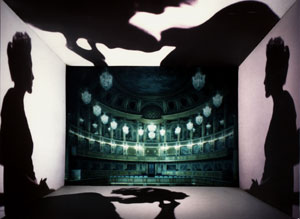

The Death of
Don Juan
Opera in Two Acts
Music and libretto by Elodie Lauten
Composed: 1985 Revised: 2005, 2010
PRODUCTIONS
LP Release, Cat Collectors, 1985 (Acknowledgement: National Endowment
for the Arts Opera & Musical Theater Program)
Concert Version, Institute of Contemporary Art, Boston, 1987 (Acknowledgement: Massachusetts Council for the Arts)
Workshop production, Franklin Pierce College, directed by Robert Lawson, 2005
In lieu of orchestra: Fairlight Computer Musical Instrument (on tape)
Improvising instruments: synthesizer, harpsichord, electric guitar
Languages:
English, French, Italian, German, Greek
The Death of Don Juan addresses the myth rather than the story
of Don Juan. In this opera, Don Juan is an archetype, a symbol of human
desire and the heroic search for divine knowledge. Placed in the modern
world, he is an artist or a rock musician, faced with the newly acquired
power and independence of women and this realization transforms him.
Don Juan confronts the spiritual elements of death, rather than simply
its physical aspect. He's facing an explosive enlightenment; how he
reacts and comes to terms with this experience is the basis of the story.
Everything happens within Don Juan's consciousness - the other characters
are visions and projections of his own mind. So the actual protagonist
is not Don Juan himself, but his soul in its most timeless form. Thus,
Don Juan can appear in different time frames and be played by multiple
performers or just be a screen character, not in the flesh. In "real
time", the opera is actually Don Juan's terminal experience. At the
beginning of Act I we find Don Juan, reflecting on the events of his
life, absorbed in his thoughts (Vision). He is interrupted by a nightmare come to life: Death appears to him in the form of a group
of women (Death as a Shadow herself, and 3 other Death Ladies, one French,
one Italian and one German). They remind Don Juan of the many women
he has known, but to him, they represent the Female principle. He is
overwhelmed, but between Death and Don Juan, an ambiguous relationship
develops, somewhere between passion and destruction, death and redemption.
Don Juan is seduced by Death
or is it the opposite? For a moment, Don
Juan is enlightened: he realizes that he has to make amends, that his
lifelong search for pleasure and ego-fulfillment and his disdain of
women has deprived him from the experience of true love and he enjoys
a brief moment of peace. In Act II he is back to his old over-confident
self, and he attempts to seduce Death as a Woman. When this attempt
fails he becomes angered and challenges death to a psychic duel. After
the fight Don Juan is left in despair. As he struggles with thoughts
of unfulfilled love and self-destruction, other voices surround him,
repeating random words, driving him to insanity: he may have another
life as a female! The following bitter-sweet Kyrie Eleison (Lord, have
mercy) concluding the opera, expresses universal compassion and forgiveness.